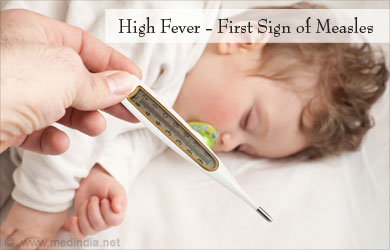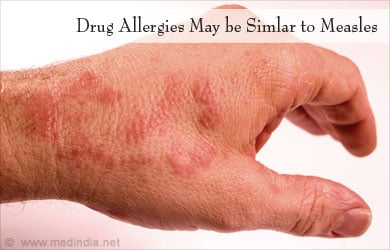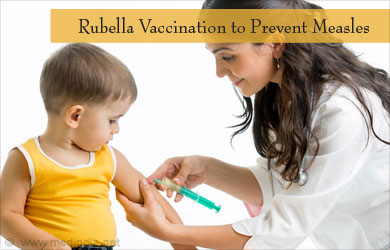- Measles - (http://www.mayoclinic.org/diseases-conditions/measles/basics/symptoms/con-20019675)
- Measles: Questions and Answers - (http://www.immunize.org/catg.d/p4209.pdf)
- Measles (Rubeola) - (http://www.cdc.gov/measles/about/signs-symptoms.html)
- Measles Vaccination - (http://www.cdc.gov/vaccines/vpd-vac/measles/)
- Measles - (http://www.dermnetnz.org/viral/morbilli.html)
- Measles - (http://kidshealth.org/parent/infections/lung/measles.html#)
- Measles Disease & Vaccine Information - (http://www.nvic.org/vaccines-and-diseases/measles.aspx)
What is Measles?
Measles, also known as morbilli or rubeola or red measles, is a highly contagious viral disease caused by a virus belonging to paramyxovirus family. It causes upper respiratory symptoms, fever and rash.
Measles is a vaccine-preventable disease. Vaccinations have led to a 79% reduction in measles deaths from the year 2000 to 2014 all over the world. In spite of this, measles is one of the main causes of death in young children. About 114 900 individuals died from measles in 2014; these included mainly children below 5 years of age. Measles mostly affects unvaccinated children. Few parents do not vaccinate their children due to fear of pain, needles or adverse side-effects, which makes the children susceptible to the infection. Measles is still common in many parts of the world including some countries in Europe, Asia, the Pacific, and Africa.

What Causes Measles?
Measles is caused by a virus belonging to paramyxovirus family. Once the virus enters the body, it resides in the nasopharynx and causes symptoms.
Transmission of measles takes place from an infected person to a person without immunity to the viral infection. When infected people cough or sneeze, they release the virus into the air. This virus can survive in the air or on contaminated surfaces for even up to two hours. Any person who is in close contact with the infected person or contaminated surfaces can get this infection. The patient is highly infectious for four days before the appearance of a rash until about four days after the rash appears, and should therefore be preferably isolated during this period. The time from contact with the virus until onset of symptoms is about 10 days but may be from 7 to 18 days.
More than 90% of unvaccinated people will get the disease when exposed to the virus. Other common conditions in which people(unvaccinated) who are prone to measles infection are immunodeficiency, malnourishment, pregnancy and frequent travelers to endemic areas. Vitamin A deficiency is also one of the risk factors for measles. Children with very little vitamin A in their diets are at a greater risk of getting infected with the virus.
What are the Symptoms of Measles?
Symptoms and signs of measles mainly appear 10 to 14 days after exposure to its virus. They are:
- High fever, which may increase to even more than 1040 Fahrenheit, especially at the onset of the rash

- Respiratory symptoms like runny or blocked nose, sneezing, sore throat, dry cough
- Eye- related symptoms like inflamed eyes (conjunctivitis), watering of eyes, swollen eyelids and increased sensitivity to light
- Koplik's spots, which are minute grayish-white spots in the mouth on a red base. These appear and disappear before the onset of skin rash
- General symptoms like muscle aches, loss of appetite, weakness
- Blotchy dark red Skin rash all over the body. Rashes throughout the body are a classic sign of measles. The rash normally begins around two weeks after exposure to the virus. It appears as flat red spots near the hairline and behind the ears, and then extends downwards to the neck, trunk, arms, legs and feet. These red spots may join each other as they extend from the head to all over the body. The fever and rash subside even(6-10 days)without treatment.
What are the Complications of Measles?
- The possible complications of the measles are diarrhea, middle ear infection or otitis media, pneumonia and encephalitis. Rarely, complications of measles can be fatal. Measles infection can take a serious course in malnourished children, mainly in those with vitamin A deficiency.
- Measles can also complicate to bronchitis, croup, corneal ulceration leading to blindness, acute glomerulonephritis and mouth ulceration.
- Measles in pregnancy can complicate its course with premature labor and delivery, fetal loss and even maternal death.
How Do You Diagnose Measles?
The identification of clinical signs and symptoms of measles such as the typical rash that starts at the hairline and gradually spreads all over the body and Koplik spots in the mouth are the main steps in diagnosing measles. In many cases, a clinical diagnosis is sufficient to conclude the presence of measles and isolate the infected person for a minimum of 5 days after the emergence of the rash, to avoid spread of infection to others.
Additionally, IgM antibodies against measles virus can be detected through serological testing and/or viral culture or reverse transcription–PCR of throat swabs, blood, nasopharyngeal swabs and urine samples can be employed for the detection of the virus.
There are many other diseases having similar symptoms as measles; therefore they have to be ruled out. They are as follows:
- Rubella
- Scarlet fever
- Serum sickness
- Infectious mononucleosis
- Roseola infantum
- Drug allergies

- Erythema infectiosum
- Kawasaki's disease
- Secondary syphilis
- Rocky Mountain spotted fever
- Toxic shock syndrome
- HIV infection
- Viral infections like enterovirus, echovirus and coxsackievirus infection, dengue fever, parvovirus B19 infection, and herpes virus infection
For an accurate diagnosis, antibodies in the patient’s blood can be measured. After a few days following the onset of the rash, measles virus-specific IgM antibodies increase in the blood and remain high for a month or two. A four-fold increase in IgG levels from the initial stages of the symptoms to the recovery phase is also indicative of measles infection. IgM antibodies can also be detected in the patient’s saliva. The virus can be detected from samples obtained from the nasopharynx, conjunctiva, blood or urine.
How Do You Treat Measles?
There is no particular anti-viral drug to cure measles, and patients usually recover completely without any definitive treatment. The symptoms can be treated to reduce the severity of the disease. Treatment includes:
- Acetaminophen and ibuprofen can reduce fever and pain associated with measles. These drugs should be taken under a doctor’s guidance only. Don’t give your child aspirin in the presence of a viral disease, as it’s related to the development of Reye syndrome.
- Take enough rest
- Always be well hydrated to prevent dehydration
- A vaporizer or humidifier may lessen the cough
- Vitamin A supplements should be taken on the advice of a doctor. Since low serum levels of vitamin A are associated with severe diseases due to measles, vitamin A treatment is recommended for all children with measles, especially in the developing world.

- Antibiotics or hospitalization may be needed, in case of any infection or other complications during measles.
- To avoid light sensitivity, wear sunglasses or keep the lights low. Avoid watching television or reading.
- If your child’s illness is getting worst or worrying you, then contact your doctor immediately.
How Do You Prevent Measles?
Measles is a vaccine-preventable disease. The vaccine has reduced measles-related child death to a considerable extent. Children should get vaccinated with two doses of the measles vaccine (sometimes given in combination with the mumps and rubella vaccines) according to the immunization schedule of the resident country. MMR Vaccine is given in two doses. In children, first dose is given at 12-15 months of age and second dose at 4-6 years of age (can be given earlier if at least 28 days after the first dose). Adults who were not vaccinated as children and who never had this disease should also be vaccinated. The vaccine should be avoided in situations like pregnancy, children with leukemia or other cancers, tuberculosis or history of drug allergies, or in individuals with weak immune system. It has few side-effects like fever and measles-like rash, which is not infectious and ceases on its own. In rare cases, the vaccine has been associated with brain damage, seizures, deafness and coma.
People unvaccinated against measles and those who are immunocompromised and have been in contact with a person with measles should be excluded from school and childcare for 14 days from the day the rash appeared in the person diagnosed with measles to avoid transmission of infection.
If unvaccinated contacts receive the measles mumps rubella (MMR) vaccine within 72 hours of their first contact with measles infected person, they may return to childcare, school or work.
Women (unvaccinated) planning for pregnancy should be vaccinated with MMR vaccine at least 28 days before becoming pregnant or immediately after delivery.
If you or any of your family members has measles, then stay at home and limit interactions with others and outdoor social activities to prevent spread of infection to other people. You can again resume your outdoor activities after your treatment is over and under your doctor’s advice.

 MEDINDIA
MEDINDIA
 Email
Email
my mom n brother suffers from measles n mumps from last couple of, i am a student of pharmacy and i suggest them exactly these treatment and they are quiet well now.
i am realy happy for u becase your mom and brother would bne dead by now
measles are one of the most terrible things that could happen to anyone
Consult Dermatologist Online
Dr. Vijay Gupta
MD
9 years experience
SKINCITY, pilibhitbypass Road, Bareilly
Dr. Jaypriya C.D
MBBS
15 years experience
Saravana Clinic, Ashok Nagar, Chennai
Dr. Riswana Nasrin Nazeer Ahamed
MBBS, MD
7 years experience
Chua and Arif Specialist Clinic , Bandar Seri Begawan, Gadong
What's New on Medindia
Articles
Follow @MedIndia
Measles - Related News
Drugs for Measles